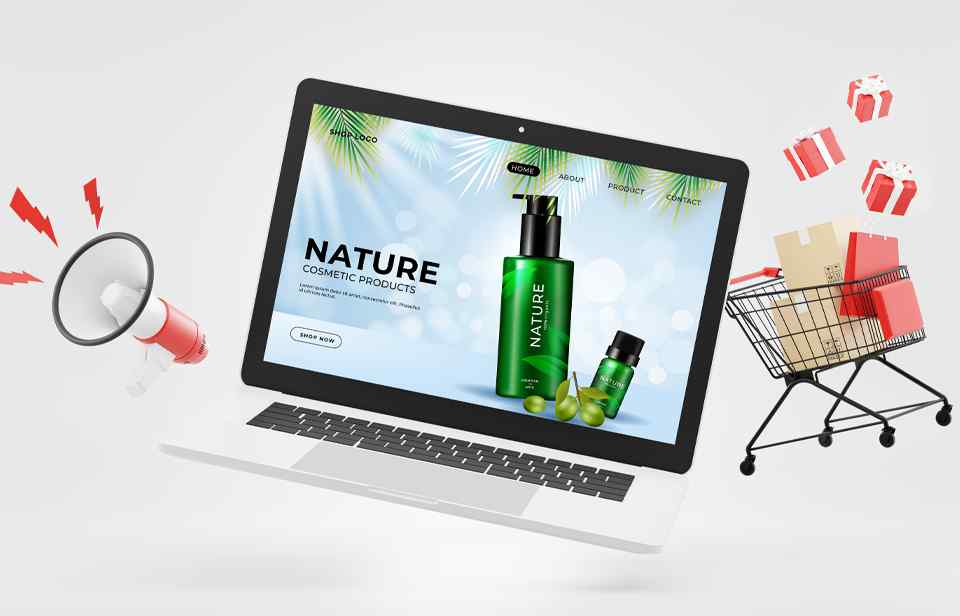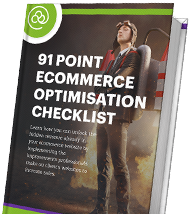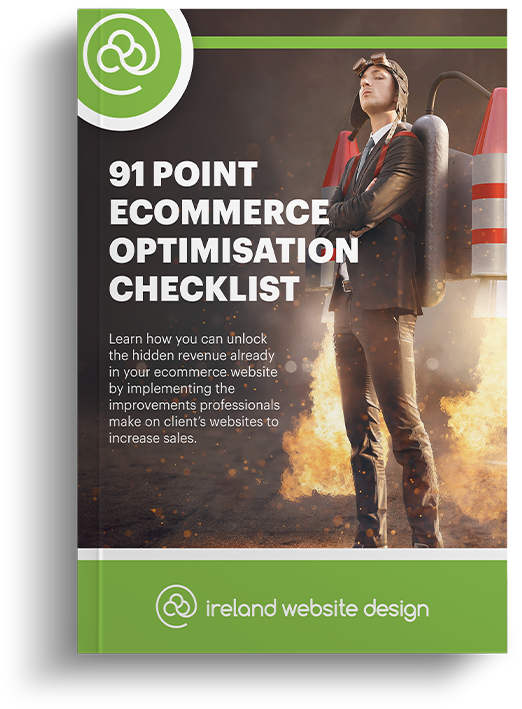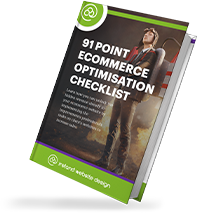Whether you’re a small boutique owner or a super-sized online store, having a digital marketing strategy is crucial for your success online.
With the Irish retail sector struggling to recover from covid lockdowns, it’s more important than ever before to embrace selling online.
A key part of owning an online store is knowing how to promote it and where to attract the customers you’re looking to sell to.
So, how do you crack eCommerce marketing? By implementing these 20 marketing tactics into your business!
But first, let’s look at what eCommerce marketing actually is.
What is eCommerce marketing?
eCommerce marketing is a type of marketing aimed at helping attract more visitors to your online store and ultimately convert them into paying, repeat customers.
Having a well-researched eCommerce marketing strategy is key to running a successful online store. Without a clear strategy, it’s like trying to shoot a target in the dark – without a floodlight highlighting the field and showing you exactly where you need to aim, you’re unlikely to hit that bullseye.
So, let’s go over the 20 best digital marketing techniques and ideas that you can implement in your business to help you gain more traffic and attract paying customers.
1. Optimise your product descriptions for SEO
If you’ve got great product descriptions, that’s fantastic, but if they’re not optimised for SEO then they’re not going to help your business get seen on the search engines.
After all, if your audience can’t find your products online, they can’t buy them.
To improve your product descriptions for SEO you need to ask yourself:
- What are people typing into Google to find your products?
- Are you writing unique product descriptions or are you copying and pasting someone else’s?
- Are you focusing on the benefits or the features of your products?
Here are a few ways you can optimise your product descriptions for SEO:
Don’t write for bots, write for buyers
You might think that writing for Google’s web crawlers is the best way to improve your ranking, but it’s not.
What’s good for your audience is good for the search engines, as nowadays, Google is mainly concerned about usability, relevance, and user engagement.
Your product descriptions should help your visitors find exactly what they’re looking for, answer any questions they may have, and ultimately complete their purchase. Google measures all of this – so if you can get your visitors to spend time on your site, reading your descriptions and ultimately buying, Google is going to rank you higher on their results page.
Go into the details of your product’s benefits, not just their features
You can’t write an informative and accurate product description unless you’re giving a good level of detail. If you only provide your audience and the search engines with a vague summary of the product, it’s not going to be of much use to them.
Be sure to write an informative, persuasive description that sells your product.
Say you sell office furniture. Your best-selling product in-store is an ergonomic chair.
Online, you list its colour and dimensions.
That’s it. It doesn’t sell online.
What’s the problem?
Your online visitors aren’t getting the full sales pitch like your in-store visitors are.
Go to town on that product description!
Tell your website visitors about how it’s a revolutionary ergonomic design that reduces back pain, improves staff productivity, looks stylish, and ultimately improves the aesthetics of their office and the health of their employees.
So, you’ve gone from ‘black office chair’ to ‘life-changing, profit-inducing, stylish office furniture that impresses your customers and keeps your staff happy’.
Which one would you buy?
Target the right keywords
When optimising your product descriptions for search engines, you should include relevant keywords.
Keywords help search engines understand what your website is about, which will, in turn, help potential customers find what you’re selling.
But how do you find the right keywords? And how do you actually use them?
It’s all about knowing your audience, narrowing down your options, and choosing the right phrases – which can be easily done with a keyword tool like SEMrush or Moz Pro.
These tools will let you research relevant keywords and give you data like:
- How many people search using each keyword
- How hard the keyword is to rank for/how much competition you have
- Related keywords that will work well in your content to attract more customers to your site
Place your keywords strategically in your product descriptions
As soon as you’ve got some high quality, relevant keywords, it’s time to place them strategically into your product descriptions.
Now, it’s important to remember not to keyword stuff – which can be easy to do in short descriptions. Keyword stuffing can actually get you penalised by Google so it’s best to only put in your keywords when you need to. Keep it natural!
If you want to avoid keyword stuffing focus on implementing keywords in:
- The page’s URL
- The product description title
- The body copy (once or twice throughout)
- The alt image text
2. Create high-quality, unique content
If you want to promote your business and sell more products, then you’re going to have to start creating more content for your website.
We’re talking more than just product descriptions – if you have detailed blog posts on your website then you’ll rank higher on Google and attract more people to your online store.
Creating written content is absolutely fantastic for Google (and potential customers), but don’t underestimate the power of video too. Beautiful, professional photos and videos of your premises, your staff, and most importantly your products, can help you sell a lot more.
Visitors will be able to see that you’re a trustworthy and professional business that creates unique, engaging, valuable, and interesting content – showing you as the experts you really are.
3. Encourage product reviews
Reviews are a great way to build up trust for both your company and your individual products. Online buyers aren’t able to see you in person or engage with the product physically, so they rely on reviews from previous customers to help them make their purchase.
Having positive reviews on your website will help your customers feel comfortable about buying your products.
Product reviews can also be used to promote your website online via Google My Business or social media.
You can encourage your customers to leave reviews of your products or services by offering special discount codes post-purchase in an automated email campaign.
4. Use social media – the right way
Social media is a gold mine when it comes to eCommerce marketing. Everybody is on some form of social media – and your business should be too.
If you’re not on social media already, do some research to figure out which platform is the most popular with your customers and create an account. Facebook and Instagram are still the big winners for promoting online shops in Ireland.
If you already have profiles on social media, then it’s time to get good use out of them!
- First rule of thumb: post quality content on your social media every day.
- Interact and engage with your audience so you can gain their trust and become a memorable brand to them.
- Optimise your profiles and make sure all the information you have on them is relevant and up to date – that goes for phone numbers, addresses, your logo and products listed for sale.
- Upload high-quality images as your profile pictures and your banners.
- Link back to your website on your profile – and your posts/updates. Social media should be a funnel to get people back onto your website to buy from you.
- When you post about individual products, make sure to link directly to the product on your website – make it as easy as possible for someone to buy from you.
How to use social media as a promotional tool
Did you know that 62% of consumers share online deals with friends on social media? Harness the power of online word of mouth and get people to share your company’s posts.
To get the most out of social media – and get people to share your content is by building a social media marketing plan. Your social media plan will help you to decide what you want to promote and when.
Consider using competitor research to help brainstorm what sort of content you want on your profiles and how it can help you promote your products.
As soon as you build up a following on your social media you’ll be able to market a lot easier.
By engaging with your customers and encouraging them to share your content with giveaways and prizes you’ll be able to reach more people.
5. Use email marketing to promote your eCommerce store
Email marketing is often the backbone of any online marketing strategy. It’s one of the best ways to nurture the relationship with your customers and encourage repeat purchases.
Email marketing continues to deliver the highest ROI compared to any other marketing strategy.
To encourage repeat sales, you can send out emails to your previous customers with offers and discounts to encourage them to buy from your store. You can also send them emails suggesting related products they might be interested in.
Email marketing is one of the most cost-effective methods of online marketing – and offers a great way of tracking customer approval rates and return on investment.
6. Offer referral discounts
Referral discounts are a great marketing technique that not only secures a repeat customer but also gains a new one.
How does it work? Basically, offer a discount to your current customers if they refer your business to a friend. People trust their friends/family members for recommendations on where to buy what they need – so encouraging word of mouth referrals via small discounts or offers is a great boost to online sales.
7. Start a loyalty program
The average conversion rate is somewhere between 1% and 3% – but your average repeat customer has a 60 to 70% chance of converting.
Existing customers are so much easier to sell to again than trying to persuade new customers to buy from you. This is why it makes so much sense to encourage these already-converted customers to make repeat purchases.
One of the most effective ways to do this is by setting up a loyalty program.
By offering your customers bonuses, points or discounts off future purchases, you can incentivise them to continue to shop at your store.
8. Use Google Shopping
Google wants us to make the user’s shopping experience as comfortable as possible which is why they created Google Shopping.
Unlike the regular Google search, where you type in what you’re looking for, on Google Shopping the user is presented with shopping ads. They tell the customer about the product, the price and when clicked on, the ad will bring them directly to where that item can be bought.
Google Shopping is huge for online retailers – if you’re not already using it, we highly recommend you start sooner rather than later.
Here are a few reasons why Google Shopping can help promote your business:
- Pre-qualified traffic: If somebody clicks on your Google shopping ad, they’re more likely to follow through with a purchase because they were specifically looking for that particular product – you don’t need to work so hard to convince them they need the item, they already know.
- A better user experience: When your customer clicks on the advertised product it takes them straight to the product page so they don’t have to go searching through your website.
- Higher conversion rates: That better user experience means that they’re not going to get annoyed with the number of steps involved with buying a product. Which means they’ll be more likely to complete the purchase.
- Clear customer intent: Shopping ads tend to come up when the user is specifically looking to buy something, which means they’re more than likely going to purchase it.
9. Video marketing
Video marketing isn’t anything new – but it’s definitely proving to be a powerful tool in the world of online promotion. Your organic traffic can improve by up to 157% if you add video content to your product pages. Not only this, but 4x as many people would prefer to watch a video than read a description of a product.
Video marketing helps expand your influence online too. People are more likely to share a video on social media than a text description – which will ultimately get your business more attention and awareness.
Having video content on your website can also improve your SEO. People will tend to spend a longer amount of time on a page if they’re watching a video. The more time they spend watching the video the more Google will see your website as a high-quality store and boost your ranking.
10. Start guest blogging
Guest blogging is a great way to get your business noticed online. If you can write an informative, valuable, and well-written piece of content for a well-respected publisher in your niche, then you can get some serious brand awareness for your company.
Research who the top bloggers, publishers, and reviewers are in your industry and get in contact with them to see if they’d allow you to submit a guest article to their blog.
Most bloggers will allow you to put a link to your store in the author’s bio but you might also be able to get one in the content itself.
Guest blogging is a great way to expand your reach and show your industry exactly what you have to offer.
11. Hold social media contests
Social media contests are a great way to gain awareness of a new audience. A few years ago, many companies did the ‘like and share’ type of contests on Facebook – these are heavily regulated now, so if you’re considering doing a social media contest, make sure you’re adhering to the platform’s rules first.
Once you’ve made sure you’re ticking all the platform’s boxes, a competition is the perfect way to boost customer engagement and get some low-cost publicity.
Offer up one of your products, a gift voucher, or a selection of your products, as a prize and post about the opportunity to win it on your social media.
12. Paid advertising on social media
Retargeted social media adverts are fantastic. Basically, you embed a retargeting pixel onto your website, which then tracks your site’s visitors when they log into their social media account. They then keep seeing your adverts on their social feed until they either visit your site again or click ‘hide ad’.
By targeting people that have already shown an interest in your company, you’re more likely to get a conversion from them than someone brand new to your sales funnels.
With the super in-depth user data stored by Facebook and Instagram, you can choose to show your non-retargeted ads to very specific groups of potential customers – including those that have liked your competitors.
13. Provide free samples
A strategy that is quite often ignored is providing your audience with free samples. Many retailers may see this as a negative form of promotion, but it can actually be incredibly effective.
If you want to show your audience how great your products are, but there’s something holding them back, try giving them a free sample or free trial.
Obviously, this suggestion isn’t suitable for everyone – but when logically possible, free samples and trials work really well.
Once they’ve enjoyed their free trial/sample, you can then ask them to review your product for you so you can get some customer feedback. You can then use this feedback to promote your product online to show how good it is.
This works especially well if your company is releasing a brand new product as your customers are going to be interested in what it is, but might need an extra push to purchase.
14. Send out vouchers with online orders
So you got them to buy from you. Now, they wait a few days for their order to come through the letterbox. Everybody loves finally getting their hands on their online order – and when they open it up and find their product nestled in surprise bonus vouchers? Happy days!
Your customers are more likely to buy from you again if you send them incentives like a 15% off voucher, refer-a-friend discount, or the promise of a special offer to thank them when they leave a review.
15. Optimise your product names
Creativity and fun really make your website stand out from the competition, but when it comes to your product names, make sure you’re including the most important info and relevant industry-standard descriptors.
Keep it simple and straightforward – including brand names and model numbers if needed.
You should be using relevant keywords in your product names so that your customers can find them easily on both the search engines and on your website’s search functionality.
For example, if you sell scarves instead of having ‘ladybird’ as a product name add in the keyword ‘scarf’ as that’s what your customers will be looking for. So, your product name would become ‘ladybird scarf’.
This doesn’t just help your customers though, it also helps search engines crawl your site and match your products to what the user is searching for.
16. Sponsor local events
Not all eCommerce marketing techniques are online!
Sponsoring local events is a great way to get your business out there to your local community. Get links to your website added onto any promotional materials for the event too.
If there are goodie bags, or giveaways happening during the event you can always ask to either be included as a prize or put a leaflet or a couple of vouchers into the goodie bags to help encourage people to check out your store.
Before and after the event post a blog about the event on your website. Talk about the event, why you were there and what the event was for. This will help your company appear in local search results and get local customers to support your store.
17. Get involved with influencers
Many companies partner up with influencers to help promote and advertise their products.
What are influencers?
Influencers are individuals who have a large following on social media within a particular industry. For example, there are makeup influencers who talk about different makeup products, give makeup tutorials and tell people which brands to buy.
As they’re seen as authorities in their niche, many consumers consider them the go-to place for advice on what to buy and where to buy from.
How can influencers help promote your products?
Influencers dedicate their lives to building up large followings online. Some of their followers will even take their opinions as gospel which is why they’re great for promoting your products.
If you have a new product you want to promote you can get in contact with an influencer in your niche and ask them to try it out, use it and review it on their platform.
Sometimes influencers will do this for the free products but other times there is a fee for the advertising, it all depends on the individual influencer and the amount of sway they have in the industry.
18. PPC advertising
PPC (pay per click) advertising is pretty much a standard in online advertising.
If you’re looking for quick results, PPC is a great way to get people on your website – but this form of advertising can eat up your budget pretty quickly.
If you’re using PPC, you’ll want to make sure your website is fully optimized for conversions and user friendly. If it’s not then you might have wasted a lot of your money on PPC – getting visitors to your site and getting them to buy from your site are two completely different things.
19. Add alt-text to your images
Image alt-texts are essentially a description of what is happening in an image. Alt-text is usually used to help assisted technology read out what is being displayed on the screen, but it’s also used to improve SEO.
By including relevant keywords in your alt-text you can improve your chances of showing up in relevant searches.
20. Offer online-only deals regularly
Everybody loves a good deal and if your audience sees that you’ve got a sale on in your store they might just be convinced to go check it out.
Offering online-only deals is a great way to promote your business and encourage online sales over in-store.
With these 20 tips, you’ll be able to promote your online shop, attract new customers, and improve your site’s conversion rate.
Want to create a digital marketing strategy to push traffic into your online store? Get in touch with the team at Ireland Website Design and we can help you out.




